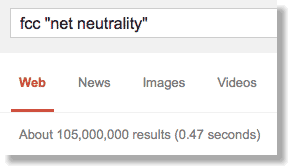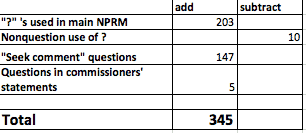Net Neutrality NPRM:
Usual Problems in FCC Drafting Persist

Readers may recall this table from a 4/30/14 post:

The questions in the net neutrality NPRM start in para 2 with
We start with a fundamental question: What is the right public policy to ensure that the Internet remains open?
Then there is a pause until we get top para. 35 with its 3 questions:
But then the rate of questions rises with crescendo, although scattered throughout the NPRM. Pages 17, 18, 54, and 61 have 9 questions of the “?” form and pages 28 and 32 have 10 such questions!In light of the important role that the Internet now plays as a vehicle for communication of all sorts—both for consumers and content providers—how should we consider the potential impact on social and personal expression of an Internet whose openness was not protected? For example, would there be particular impacts on political speech, on the ability of consumers to use the Internet to express themselves, or on the Internet’s role as a “marketplace of ideas” that serves the interests of democracy in general, serving even the interests of those Americans who listen even if they do not actively speak? Are there other ways in which we should understand free-expression interests and whether they may be impaired by a lack of openness?
So, you may ask, how many total questions are there in the net neutrality NPRM? Using MS Word to search the document without the concurring/dissenting statements we find 203 question marks. 10 of these are other than questions - mostly question marks in URLs. This gives 193 questions ending in question marks. There are 147 questions without question marks that include the words “seek comments”.
Interestingly most of these “seek comments” questions are on pages without any “?” questions, e.g. p. 37 with 9 “seek comment” questions and only one “?” question. One wonders if one group of writers prefers “?” and the other group prefers “seek comment” and they wrote different parts of the NPRM. However, p. 32 has 10 “seek comment” questions and another 10 “?” questions making it the most inquisitive page of the whole NPRM!
Comm. Pai asks 3 additional questions in his statement and Comm. O’Rielly asks 2 more in his. (Comm. Clyburn has several questions, but we did not include them in the count since they all appeared to be rhetorical -- although others might disagree.)
Note that there is even a question contained in a footnote (fn. 201) - a recurring issue in FCC NOIs and NPRMS that most would consider poor writing practice:

So what then is the grand count of question in this critical item that is supposed to be resolved in 6 months? Your blogger’s count is given below:

Net neutrality is a key issue and a major proceeding for the Commission. The poor organization of these questions, let alone the lack of numbering like the FCC’s UK and Canadian counterparts use, will greatly complicate the deliberations for both the commenters and the poor FCC staff that must read and summarize the comments.
Isn’t it time to start working on a better approach to formatting FCC NOIs and NPRMs in order to improve the timeliness of FCC deliberations?



![Validate my RSS feed [Valid RSS]](valid-rss-rogers.png)

